Bird beaks come in a variety of colors. Other than for mate selection, beak colors also represent the bird’s dominance rank, and ability to fight. Beak coloration comes from birds’ diets, particularly the carotenoids they consume. These are pigments that produce red, orange, and yellow-colored beaks as a result.
There are 22 interesting species you may or may not be familiar with, including the African Thrush, American Herring Gull, Bald Eagle, Common Blackbird, Chestnut-bellied Thrush, European Starling, Karoo Thrush, Large-billed Tern, Little Pied Cormorant, Toco Toucan, and many more!
This article will provide you with everything you need to know about these yellow-beaked birds, their body dimensions, defining characteristics, native regions, what they usually eat, and how long they would live both in the wild and in captivity!
Table of Contents
22 Birds With Yellow Beaks
African Thrush

Also referred to as the West African thrush, these woodland passerine birds are non-migratory. They were once thought to belong to the same species as the olive thrush before it was split apart.
- Scientific Name: Turdus pelios
- Appearance: The top of the head is brown with gray upper parts and lighter colors on its underwings. Flanks have an orange-chestnut color and a bright yellow-orange beak.
- Lifespan: Unknown
- Size: 21 to 23 centimeters
- Weight: 46 to 78 grams
- Wingspan: Unknown
- Diet: Earthworms, millipedes, plant matter, fruits and berries, arthropods (beetles, termites, ants, spiders)
- Place of Origin: Sub-Saharan Africa
- Characteristics: They are shy birds that are either solitary or come in pairs and prefer to be concealed in trees until it’s time to look for food.
American Herring Gull

American Herring Gulls have long since adapted to human activity as they forage near or on garbage, dumpsters, fishing harbors, and parking lots. They prefer breeding near bodies of water such as beaches, islands, and cliffs.
- Scientific Name: Larus smithsonianus
- Appearance: White head and under parts, gray upper parts, and gray with black-tipped plumage. Pale pink legs and a yellow beak with a red spot on the edge.
- Lifespan: Unknown
- Size: 56 to 66 centimeters
- Weight: 1 to 1.65 kilograms
- Wingspan: 137 to 145 centimeters
- Diet: Fish, clams, mussels, small mammals, carrion, eggs, insects, garbage
- Place of Origin: North America
- Characteristics: They’re not solitary birds since they like to stick with colonies when breeding.
American Robin Gulls
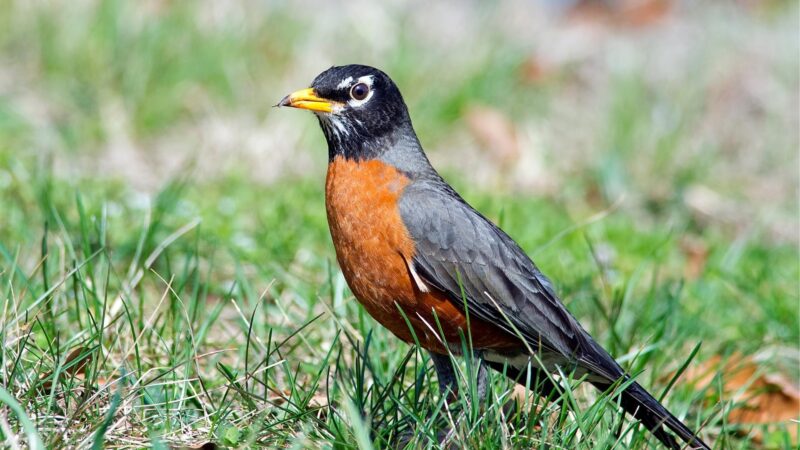
Migratory songbirds, popularly known for singing in the springtime, American Robin Gulls live across lawns, woodlands, fields, orchards, gardens, and anything with trees and shrubbery for roosting and nesting.
- Scientific Name: Turdus migratorius
- Appearance: Grayish brown upper parts, warm orange underparts with a white patch, and black heads. Yellow beaks with a black spot on the edge.
- Lifespan: 2 to 6 years (wild), Up to 14 years old (captivity)
- Size: 23 to 28 centimeters
- Weight: 77-85 grams
- Wingspan: 119 to 137 millimeters
- Diet: Fruits, berries, earthworms, insects
- Place of Origin: North America
- Characteristics: Diurnal and social birds are evidenced by their tendency to gather together during winter or in flocks at night when roosting.
Bald Eagle
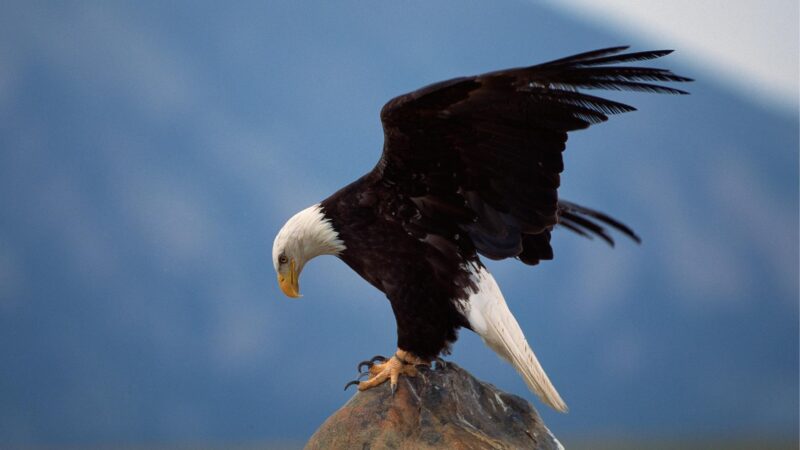
Notorious prey stealers, Bald Eagles would harass other birds of prey and snatch their food. This bird is known to be the national emblem of the USA and was once an endangered species due to hunting and pesticide ingestion.
- Scientific Name: Haliaeetus leucocephalus
- Appearance: Dark brown bodies and plumage, white heads, and bright yellow legs and beaks. Younger birds will have white patches all over their bodies and plumage and a dark head.
- Lifespan: 15 to 20 years (wild), 20 to 30 years (captivity)
- Size: 79 to 94 centimeters
- Weight: 3 to 6.3 kilograms
- Wingspan: Up to 204 centimeters
- Diet: Fish, water birds, small mammals, carrion, turtles, human waste
- Place of Origin: North America
- Characteristics: Territorial and solitary birds except during nesting and breeding season when they’re found in pairs.
Black-breasted Thrush
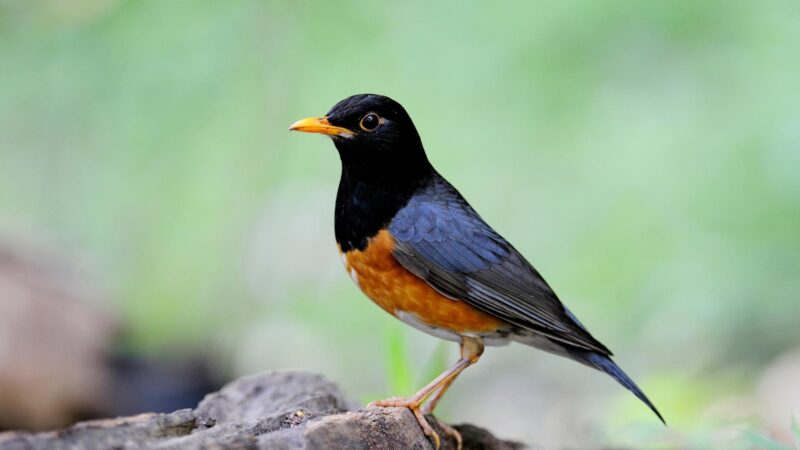
Although little is known about the species, past recorded distributions spotted one Black-breasted Thrush female in a riverine with a dense broad-leaved forest near a stream and several birds in hills, mountain summits, and plains.
- Scientific Name: Turdus dissimilis
- Appearance: Grayish brown head and plumage, yellow beak with black tip, bright orange flanks, white throat with dark streaks, and white underparts.
- Lifespan: Unknown
- Size: 22 to 23.5 centimeters
- Weight: Unknown
- Wingspan: Unknown
- Diet: Insects, fruits, berries
- Place of Origin: China, Myanmar, Northeast India, and North Vietnam
- Characteristics: Belonging to a family of songbirds, this species is capable of singing melodious sounds.
Chestnut-bellied Thrush

Another thrush with little known information, the first records of the Chestnut-bellied Thrush were discovered in 1857. Its population trend has been decreasing but is still of the least concern. This migratory bird prefers subtropical or tropical moist montane forests with ample foliage.
- Scientific Name: Turdus fulviventris
- Appearance: Black head, chestnut-colored belly, gray breast and upper parts, and yellow-orange bill
- Lifespan: Unknown
- Size: Up to 25 cm
- Weight: Unknown
- Wingspan: Unknown
- Diet: Unknown but most likely an omnivore.
- Place of Origin: Colombia, Ecuador, Peru, and Venezuela
- Characteristics: Songbirds but instead of melodious sounds, they sing disjointed tunes.
Common Blackbird

Considered a true thrush, blackbirds live in proximity to humans and may have even adapted to eating man-made food. They can change the pitch and volume of their calls based on the environment they’re in when looking for mates.
- Scientific Name: Turdus merula
- Appearance: Males have black-colored bodies and bright yellow-orange beaks, while females have brown-colored bodies with brown beaks.
- Lifespan: 2.4 to 21.8 years (wild)
- Size: 25 centimeters
- Weight: 80 to 125 grams
- Wingspan: 34 to 38 centimeters
- Diet: Large fruits that have high energy levels with little to no seeds, elder fruits, beetles, spiders, grasshoppers, snails
- Place of Origin: Europe, North Africa, South Asia
- Characteristics: Diurnal, territorial, and migratory birds that help in the seed dispersal of some fruit trees.
Common Gull
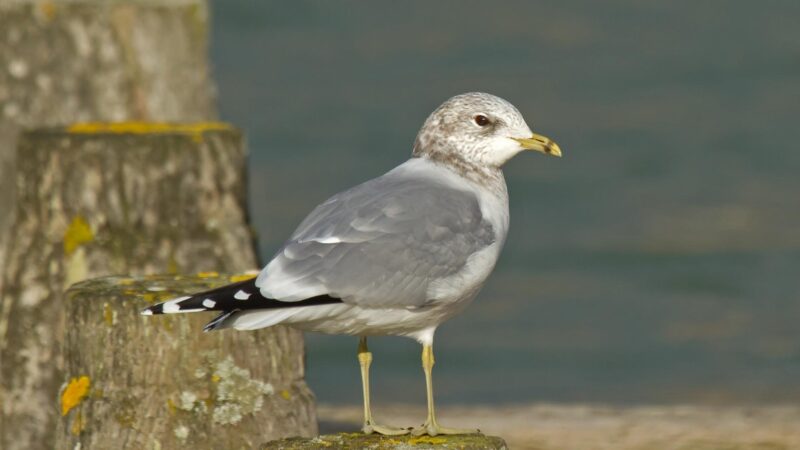
Also referred to as a mew gull or sea mew, Common Gulls play an important ecosystem role for humans and clean the habitat they live in as they’re scavengers and natural garbage collectors.
- Scientific Name: Larus canus
- Appearance: White head and underparts, yellow-green beaks, and gray and black plumage.
- Lifespan: Up to 24 years (wild)
- Size: 40 to 46 centimeters
- Weight: 290 to 552 grams
- Wingspan: 119 to 122 centimeters
- Diet: Clams, mussels, worms, grains, berries, insects, and mice, has cannibalistic tendencies when food is scarce
- Place of Origin: Northern Europe
- Characteristics: Migratory, colonial, and opportunistic birds who prefer staying near shores
European Starling

First introduced in the US by Eugene Schieffelin, a pharmaceutical manufacturer who was a Shakespeare enthusiast, let loose 100 European Starlings imported from Europe into Central Park. Breeding made them widespread and has even reached a population of 200 million in 2011.
- Scientific Name: Sturnus vulgaris
- Appearance: Iridescent green-colored bodies with black wings and yellow beaks during mating season that has a blue spot at the base for males and reddish pink for females.
- Lifespan: Up to 15 years (wild)
- Size: 21.5 centimeters
- Weight: 70 to 100 grams
- Wingspan: Up to 40 centimeters
- Diet: Plants and plant seeds, earthworms, centipedes, moths, fruits
- Place of Origin: Palearctic regions in Europe
- Characteristics: Known to be excellent mimics that can replicate sounds made by up to 20 different bird species.
Great Thrush
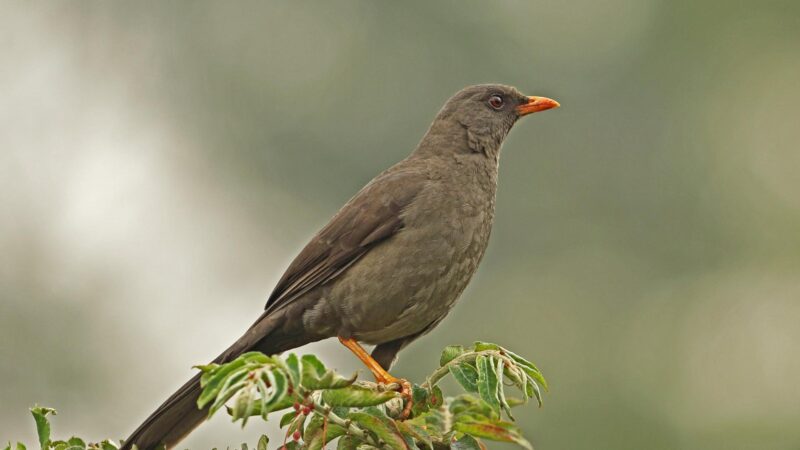
Great Thrush birds stand out and can be found in highlands with elevations of about 2 to 4 kilometers, but they’re also in open rural and urban habitats. They’re believed to have up to 10,000 mature individuals with a stable population trend.
- Scientific Name: Turdus fuscater
- Appearance: Bodies have varying shades of black to grayish brown with yellow legs and yellow-orange beaks.
- Lifespan: Unknown
- Size: 28 to 33 centimeters
- Weight: 128 to 175 grams
- Wingspan: Unknown
- Diet: Unknown, but they’re assumed to be omnivores as most thrushes are
- Place of Origin: South America
- Characteristics: Since they’re a part of a family of songbirds, this species is also capable of singing melodious sounds.
Grey-winged Blackbird
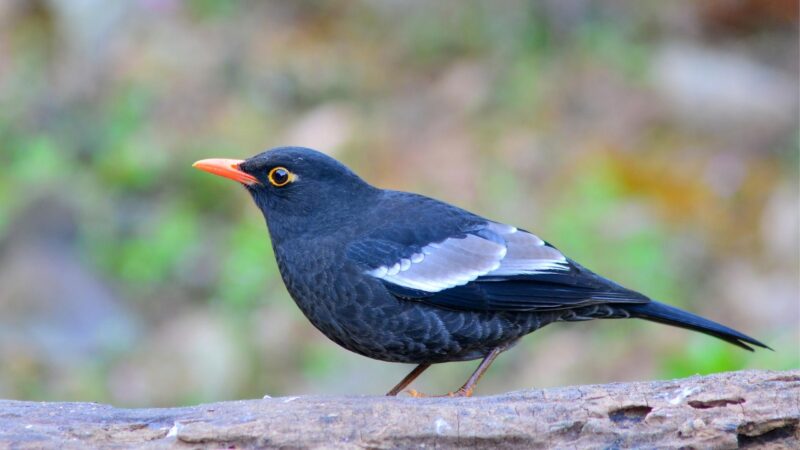
Grey-winged blackbirds are large thrushes who live dominantly and forage quietly in montane and submontane evergreen forests. They are migratory birds that fly in flocks during the winter season.
- Scientific Name: Turdus boulboul
- Appearance: Males have dominantly black bodies while females are brown, but both have bright yellow-orange beaks and grayish silver wings, which gives them their name.
- Lifespan: Unknown
- Size: 27 to 29 centimeters
- Weight: 85 to 105 grams
- Wingspan: Unknown
- Diet: Unknown but assumed to be omnivores as all blackbirds are
- Place of Origin: Myanmar, Nepal, and Northern Vietnam
- Characteristics: Solitary birds who avoid flying through gardens and sing songs that are made of jumbled-up phrases.
Indian Blackbird

Indian Blackbirds were once thought to be subspecies of the common blackbird with the scientific name Turdus merula simillimus. Their songs can be heard coming from forests and orchards, and they often live close to humans.
- Scientific Name: Turdus simillimus
- Appearance: Midnight black plumage for birds found in Sri Lanka and brown bodies with black heads and plumage for birds found in Central India. Both have a bright yellow-orange beak.
- Lifespan: Unknown
- Size: 19 to 20 centimeters
- Weight: Up to 70 grams
- Wingspan: Unknown
- Diet: Unknown but assumed to be omnivores as all blackbirds are
- Place of Origin: India and Sri Lanka
- Characteristics: These birds’ songs sound similar to flutes. Despite living near people, they don’t prefer urban areas.
Karoo Thrush

Also considered as a subspecies of the Olive Thrush with the scientific name Turdus olivaceus smithi, the Karoo Thrush is now being treated as its own species. They often skulk alone in understory layers in forests or occupy thickets, scrubs, and urban gardens with their pair.
- Scientific Name: Turdus smithi
- Appearance: Dark olive-brown bodies with reddish-brown bellies and yellow beaks
- Lifespan: Unknown
- Size: 24 centimeters
- Weight: 86 grams
- Wingspan: 1.17 to 1.31 centimeters
- Diet: Unknown but assumed to be omnivores as most thrushes are
- Place of Origin: South Africa
- Characteristics: Gives out a variety of songs, but they usually sing typical thrush calls.
Large-Billed Tern
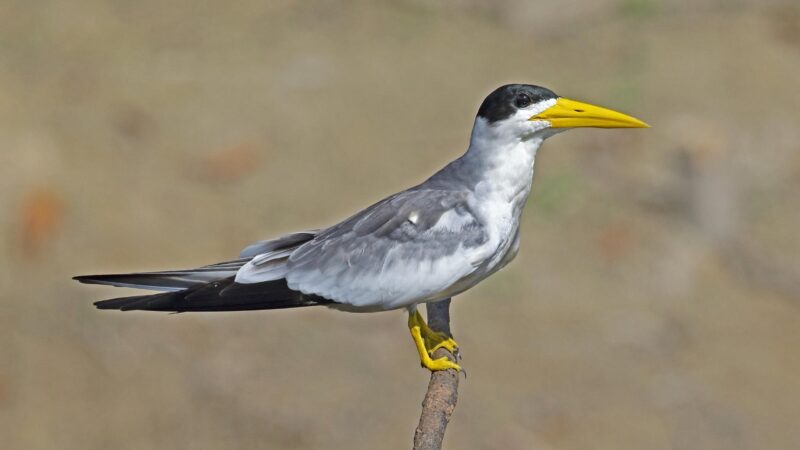
Being the only member of the Phaetusa genus, Large-billed Terns are primarily found on shorelines regardless of the season. During the breeding season, they like to coop up in coastal estuaries and sandbars of inland rivers and lakes.
- Scientific Name: Phaetusa simplex
- Appearance: White bodies with three-toned plumages of black, white, and gray, black crowns on their heads, and a yellow beak.
- Lifespan: Unknown
- Size: 5.5 to 6 centimeters
- Weight: 208 to 247 grams
- Wingspan: 13 to 14 centimeters
- Diet: Insects, fish, and other aquatic creatures (preferably invertebrates)
- Place of Origin: South America
- Characteristics: When foraging, they plunge-dive in or skim on water. These birds are very loud and vocal, making constant honking sounds and clucks.
Little Pied Cormorant

A common waterbird in Australia, Little Pied Cormorants are found on almost any body of water, specifically in fresh or salt waters. They breed in colonies but also in single pairs, although it’s a rare occurrence. They mix readily with another cormorant species, the Little Black Cormorant.
- Scientific Name: Phalacrocorax melanoleucos
- Appearance: Black upper parts and white underparts with a yellow bill
- Lifespan: Unknown
- Size: 56 to 58 centimeters
- Weight: Unknown
- Wingspan: Unknown
- Diet: Fish, freshwater crayfish, crustaceans, shrimp
- Place of Origin: Australia, New Zealand, New Guinea, and Indonesia
- Characteristics: Both social and solitary birds, as they’re often found alone virtually anywhere, except in open waterways, dams, and streams where they’re part of large flocks.
Pale-Eyed Thrush
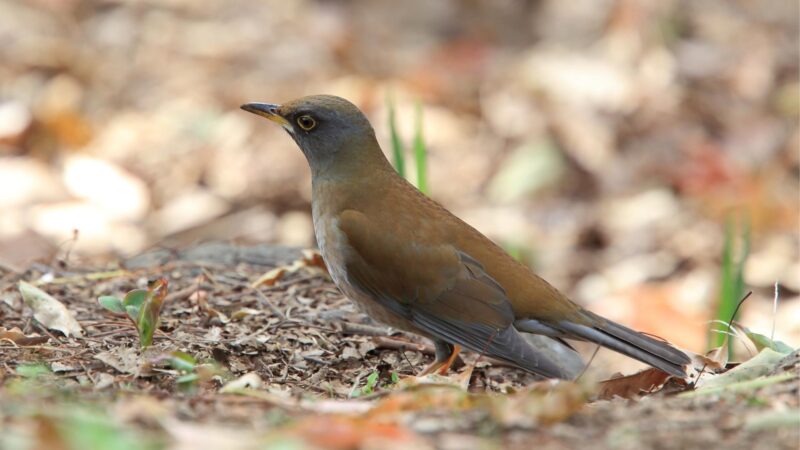
These sparsely seen thrushes are located in elevated forests at 1 to 2 km in subtropical zones. Taxonomists consider the Pale-eyed Thrush as a member of the Platycichla genus and not the Turdus genus, where most thrushes are classified under.
- Scientific Name: Turdus leucops
- Appearance: Entirely black bodies for males and dark brown for females with pale mottling found on the belly. Both have yellow-orange beaks and legs.
- Lifespan: Unknown
- Size: 18 to 21 centimeters
- Weight: 65 grams
- Wingspan: Unknown
- Diet: Unknown but most likely an omnivore as most thrushes are
- Place of Origin: Venezuela and Bolivia
- Characteristics: Females are not frequently encountered, but males can be spotted singing on tops of trees using a squeaky voice, and songs that thrushes usually give out.
Somali Thrush
Somali Thrushes, also known as the Somali Blackbirds, have an unusual dark coloration compared to typical thrushes. They’re mostly found in woodlands found in mountains, forests, and shrublands, with a population of about 6,000 to 15,000 mature individuals.
- Scientific Name: Turdus ludoviciae
- Appearance: Overall black color with pale gray bellies and yellow-orange beaks and legs. Females have slightly paler colorations with mottled streaking.
- Lifespan: Unknown
- Size: 22 to 24 centimeters
- Weight: 58 to 63 grams
- Wingspan: Unknown
- Diet: Unknown but most likely an omnivore as most thrushes are
- Place of Origin: Somalia
- Characteristics: Little information is known about the bird’s vocalizations, but it’s known to give out a typical thrush song and harsh calls.
Steller’s Sea Eagle
Considered vulnerable species by the IUCN, the Steller’s Sea Eagles are raptors that are regionally declining due to loss of habitat, lead poisoning, and reduced breeding. As of 2021, they only have a population of 3,600 to 4,670 mature individuals.
- Scientific Name: Haliaeetus pelagicus
- Appearance: Rich brown bodies, white tails, bellies, and shoulders, and massive yellow-orange beaks.
- Lifespan: Up to 20 years
- Size: 13 to 16.5 centimeters
- Weight: Up to 9 kilograms
- Wingspan: 198 to 250 centimeters
- Diet: Fish, waterbirds, small mammals, carrion, squids, crabs, and young seals
- Place of Origin: Northeastern Asia
- Characteristics: Sedentary eagles live along coastlines while migratory eagles move to Japan or Korea.
Toco Toucan
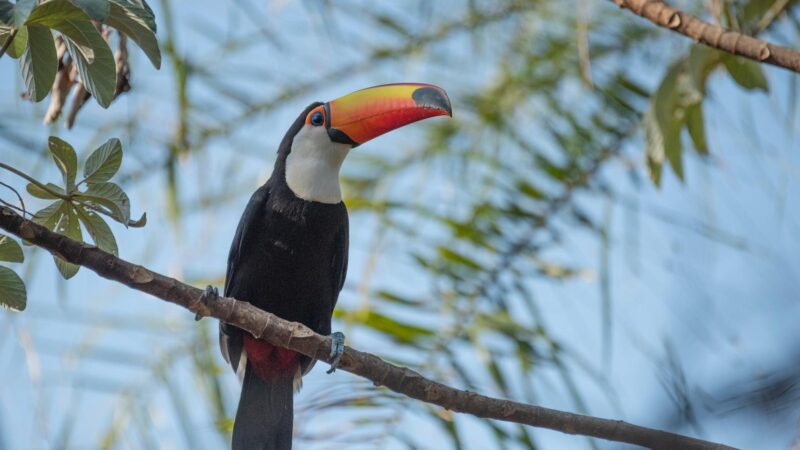
Known as the largest species in the toucan family, Toco Toucans are commonly found in plantations, woodlands, and savannas. They like to live in places that are abundant in fleshy fruits.
- Scientific Name: Ramphastos toco
- Appearance: Dominantly black with white throats and yellow-orange beaks with a black marking at its tip
- Lifespan: 20 to 26 years (wild), up to 18 years (captivity)
- Size: 61 cm
- Weight: 592 to 760 grams
- Wingspan: 17 to 24 centimeters
- Diet: Mainly fruits, insects, bird eggs
- Place of Origin: Argentina, Bolivia, Brazil, French Guiana, Paraguay, Peru, and Suriname
- Characteristics: Loud communicators that constantly produce deep croaking noises. They’re social birds and generally live in flocks consisting of about 6 members.
Western Gull
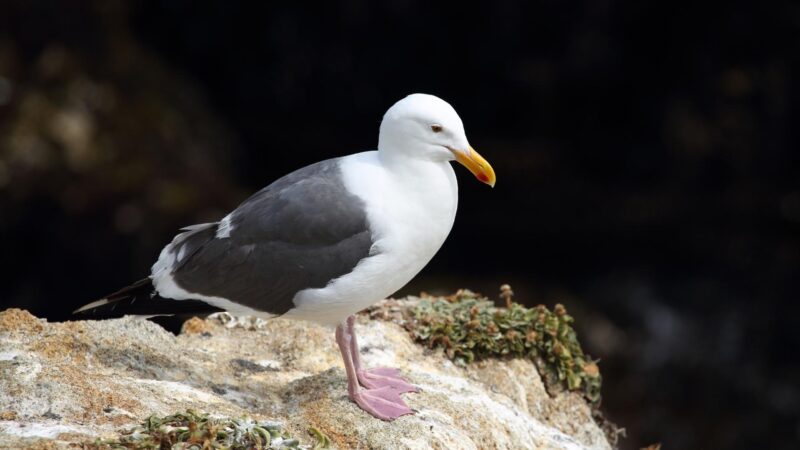
Western Gulls strictly live near coastal areas, towns, and cities but rarely venture inland. They’re scavengers who forage around fishing boats, plants that process fish, and landfills. They’re also capable of catching fish while swimming.
- Scientific Name: Larus occidentalis
- Appearance: Adult birds have dark gray upper parts accompanied by bright pink legs, white plumage, and yellow-orange beaks with a red or black marking.
- Lifespan: Unknown
- Size: 55 to 68 centimeters
- Weight: 800 to 1,400 grams
- Wingspan: 130 to 144 centimeters
- Diet: Fish, squid, jellyfish, seal carcasses, roadkills, snails, human refuse, young birds
- Place of Origin: North America
- Characteristics: Social birds that participate in mixed-breed seabird flocks.
White-Tailed Eagle

White-tailed Eagles are the largest raptors found in the United Kingdom. In the early 20th century, they were considered extinct in the UK due to illegal killing but have a population of 200 pairs in 2020 thanks to reintroduced birds.
- Scientific Name: Haliaeetus albicilla
- Appearance: Dark plumage, pale brown heads and bodies, white tails, and yellow beaks.
- Lifespan: Up to 25 years
- Size: 70 to 90 centimeters
- Weight: 3.5 to 5 kilograms (males), 4 to 7 kilograms (females)
- Wingspan: 200 to 240 centimeters
- Diet: Fish, birds, hares, rabbits, carrion
- Place of Origin: Europe and Asia
- Characteristics: Scarcely found eagle species, but they prefer living along coastlines and large rivers.
Yellow-legged Gull
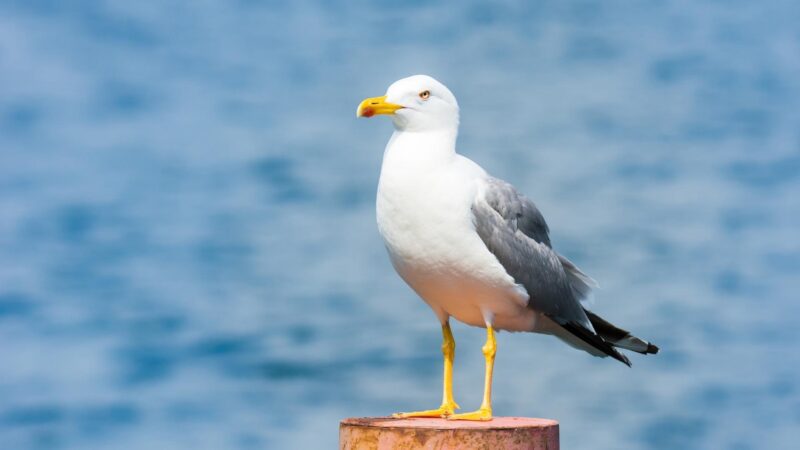
Formerly thought to be a subspecies of the Herring Gull, possibly due to their association with them, Yellow-legged Gulls are large seagulls that are mainly sedentary birds but migrate during the winter.
- Scientific Name: Larus michahellis
- Appearance: Overall white bodies with grayish backs and plumage and yellowish legs and beaks.
- Lifespan: Unknown
- Size: 55 to 67 centimeters
- Weight: 550 to 1600 grams
- Wingspan: 120 to 155 centimeters
- Diet: Unknown but is assumed to be omnivorous scavengers.
- Place of Origin: Southern Europe
- Characteristics: Social birds as often found in mixed-breed flocks mainly composed of Herring Gulls and Lesser Black-backed Gulls.
Summary
Colored beaks are indicators of dominance rank and fighting ability relative to other birds. Yellow beaks, in particular, are caused by carotenoids which help give red, orange, and yellow pigments to bird beaks when ingested. Of the 22 species of yellow-beaked birds in this list, 11 belong to the Turdus genus or are considered Thrushes, who are primarily omnivores.
List of Sources
Akinpelu, A., Oyedipe, O. A. (2005). A twelve-month field study of the West African Thrush Turdus pelios (Passeriformes: Muscicapidae). Part 1: Food and feeding ecology. ResearchGate.
Francis, O. E. (2020). Food and Foraging Ecology of African Thrush (Tuedus pellios) The Federal Polytechnic Ilaro South Western, Nigeria. ResearchGate.
Bird Beak Coloration: More Than Just a Fashion Statement. (2015). Vassar College.
